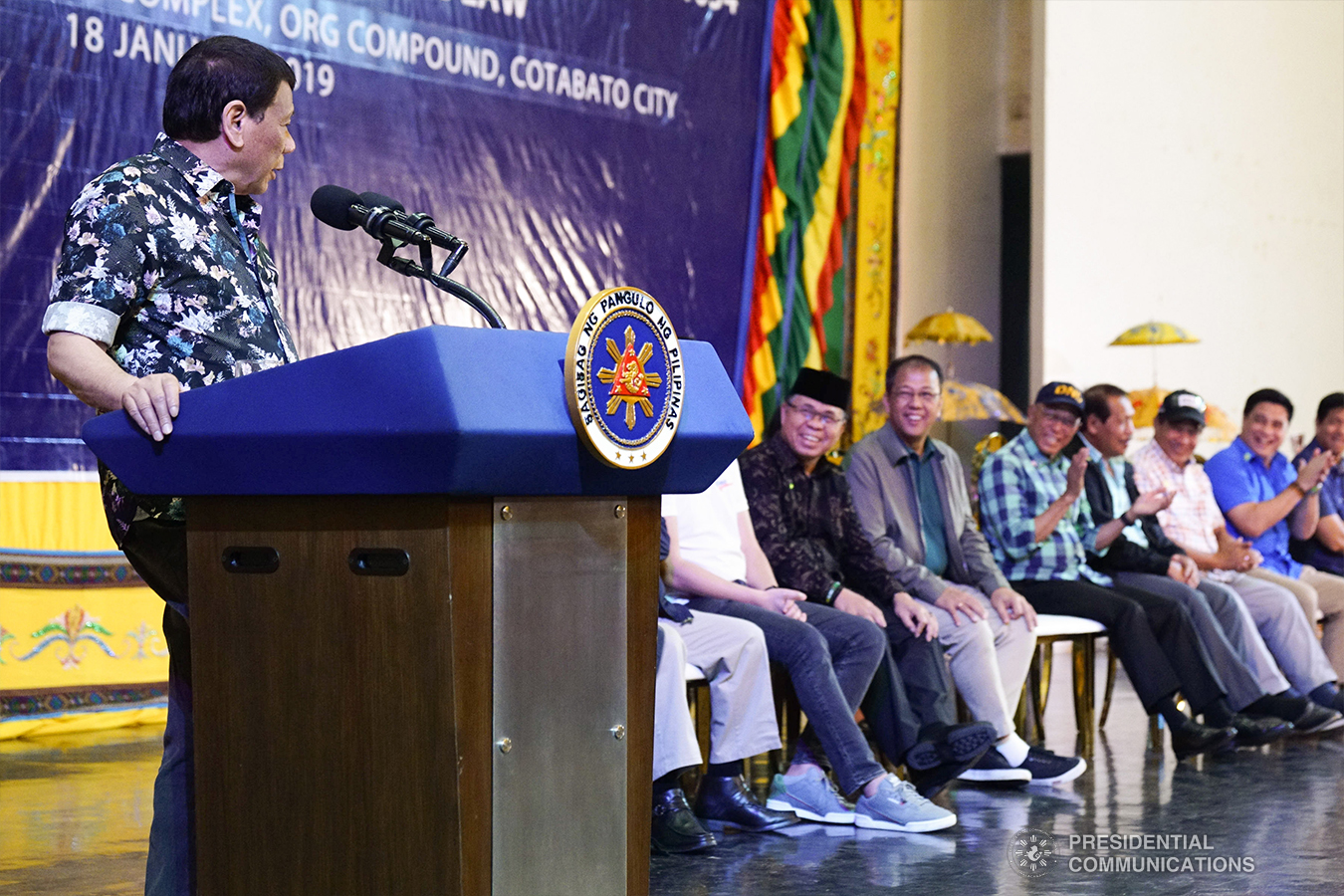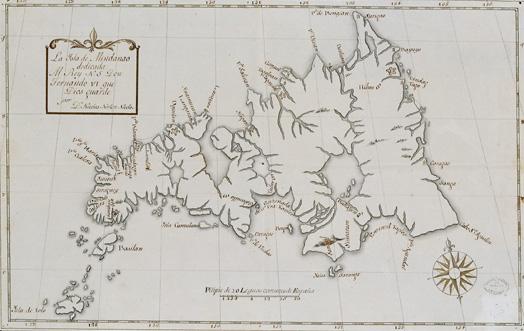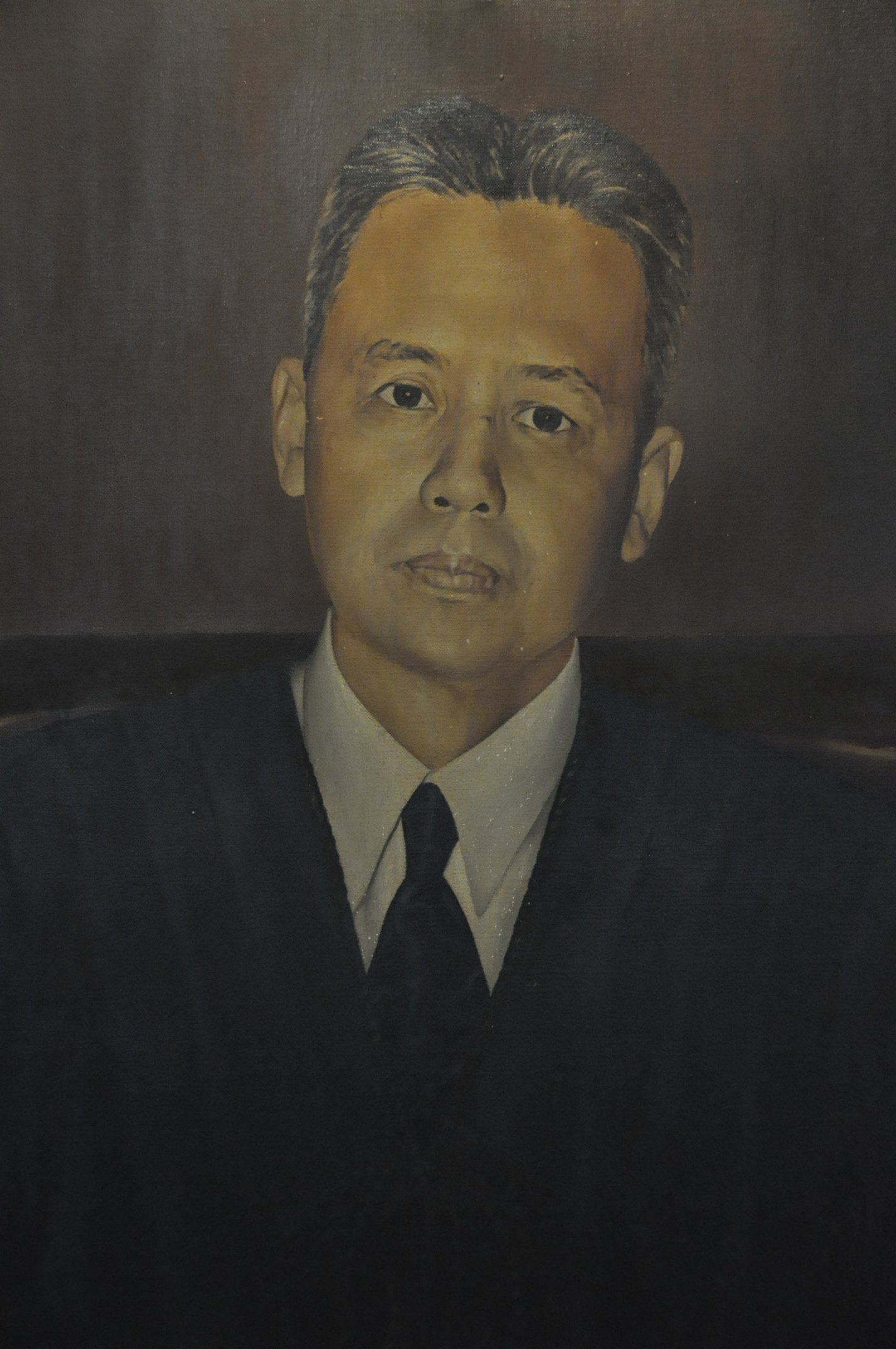|
2019 Bangsamoro Autonomy Plebiscite
The 2019 Bangsamoro autonomy plebiscite was a two-part plebiscite held in Mindanao, Philippines, that ratified the Bangsamoro Organic Law (BOL) and replaced the Autonomous Region in Muslim Mindanao (ARMM) with the Bangsamoro Autonomous Region in Muslim Mindanao (BARMM), as well as the scope of the said region. Under the organic law, the government would have to hold the plebiscite not more than 150 days from the signing of the BOL into law (July 26, 2018) but not earlier than 90 days from the law's signing. The first part of the plebiscite was held on January 21, 2019, where voters from the ARMM voted regarding the BOL's ratification and residents of Cotabato City and Isabela City voted for or against their cities' inclusion into the then-proposed region. The second part was held on February 6 to potentially expand the BARMM; with voters from six municipalities in Lanao del Norte and 67 barangays in Cotabato province voting for or against their localities' inclusion into the BA ... [...More Info...] [...Related Items...] OR: [Wikipedia] [Google] [Baidu] [Amazon] |
Mindanao
Mindanao ( ) is the List of islands of the Philippines, second-largest island in the Philippines, after Luzon, and List of islands by population, seventh-most populous island in the world. Located in the southern region of the archipelago, the island is part of an island group of the same name that also includes its adjacent islands, notably the Sulu Archipelago. According to the 2020 census, Mindanao had a population of 26,252,442, while the entire island group had an estimated population of 27,021,036. Mindanao is divided into six administrative regions: the Zamboanga Peninsula, Northern Mindanao, the Caraga region, the Davao Region, Davao region, Soccsksargen, and the autonomous region of Bangsamoro. According to the 2020 census, Davao City is the most populous city on the island, with 1,776,949 people, followed by Zamboanga City (pop. 977,234), Cagayan de Oro (pop. 728,402), General Santos (pop. 697,315), Butuan (pop. 372,910), Iligan (pop. 363,115) and Cotabato City (pop. ... [...More Info...] [...Related Items...] OR: [Wikipedia] [Google] [Baidu] [Amazon] |
Supreme Court Of The Philippines
The Supreme Court (; colloquially referred to as the ' (also used in formal writing), is the highest court in the Philippines. It was established by the Taft Commission on June 11, 1901, through the enactment of Act No. 136, which abolished the Real Audiencia of Manila, the predecessor of the Supreme Court. The Supreme Court compound is located in what was formerly a part of the University of the Philippines Manila campus. It occupies the corner of Padre Faura Street and Taft Avenue in Ermita, Manila, with the main building sited directly in front of Philippine General Hospital's cancer institute. History Early history Prior to the conquest of Spain, the islands of the Philippines were composed of independent barangay state, barangays, each of which is a community composed of 30 to 100 families. Typically, a barangay is headed by a ''datu'' or a local chief who exercises all functions of government: executive, legislative and judicial; he is also the commander-in-chief in time ... [...More Info...] [...Related Items...] OR: [Wikipedia] [Google] [Baidu] [Amazon] |
Pikit, Cotabato
Pikit, officially the Municipality of Pikit ( Maguindanaon: ''Inged nu Pikit'', Jawi: ايڠد نو ڤيكت; Hiligaynon: ''Banwa sang Pikit''; Cebuano: ''Lungsod sa Pikit''; Tagalog: ''Bayan ng Pikit'') is a municipality in the province of Cotabato, Philippines. According to the 2020 census, it has a population of 67,024 people. History Pikit was the oldest settlement ever founded in Cotabato province. The landmark which eventually became the town's namesake, Fort Pikit, was established in 1893 by the Spaniards who have by then just recently conquered what is now the province of Cotabato from the Sultanate of Maguindanao. The name "Pikit" was given to the place by the Spaniards. It was formerly called by the natives "Malasiquit" because it was situated within the shadows of hills situated to each other. The fort was built to consolidate their hold in the region. The Spaniards abandoned Fort Pikit at the end of the 19th century, which paved the way for the eventual Ame ... [...More Info...] [...Related Items...] OR: [Wikipedia] [Google] [Baidu] [Amazon] |
Pigcawayan
Pigcawayan, officially the Municipality of Pigcawayan ( Maguindanaon: ''Inged nu Pigkawayan'', Jawi: ايڠايد نو ڤيڬكاوين; Iranun: ''Inged a Pigkawayan'', ايڠايد ا ڤيڬكاوين; ; ; ), is a municipality in the province of Cotabato, Philippines. According to the 2020 census, it has a population of 52,744 people. It is sometimes spelled Pigkawayan. History Before its creation as a separate and independent Political Unit, Pigcawayan together with Alamada and Libungan were component barangays of Midsayap. Pigcawayan, however at that time was more progressive than the two mentioned. How Pigcawayan got its name remains undocumented, however two versions were given by the early settlers and passed from one generation to another. The first version was that the place now known as Pigcawayan was a battleground for the Iranuns and the Maguindanaons. Due to this fighting the inhabitants would abandon the place to be occupied by the victors. From this evolved th ... [...More Info...] [...Related Items...] OR: [Wikipedia] [Google] [Baidu] [Amazon] |
Midsayap, Cotabato
Midsayap, officially the Municipality of Midsayap ( Maguindanaon: ''Inged nu Midsayap'', Jawi: ايڠد نو ميدسايڤ; Iranun: ''Inged a Midsayap'', ايڠد نو ميدسايۏ; ; ; ), is a municipality in the Province of Cotabato, Philippines. According to the 2020 census, it has a population of 117,365 people. History Midsayap was derived from a Maguindanaon term which means (Mid) Center and (Sayap) Straw Hat. Midsayap means a straw hat at the center – just like a hill centrally located at the Municipality which slopes through the plains in a shape of a hat. Other version relates that Midsayap came from a Maguindanaon term which means "person wore a straw hat". From 1912 to 1926, Midsayap was then a district of Dulawan and Pikit. Originally, Midsayap was inhabited by Muslims from the descendants of Sultan Ali Bayao from the lineage of Sultan Dipatuan Kudarat I. The seat of their sultanate was established at Libungan Torreta (now part of Pigcawayan). In 1927, a Phi ... [...More Info...] [...Related Items...] OR: [Wikipedia] [Google] [Baidu] [Amazon] |
Kabacan, Cotabato
Kabacan officially the Municipality of Kabacan ( Maguindanaon: ''Inged nu Kabakan'', Jawi: ايڠد نو كباكن; ; ; ; ), is a municipality in the province of Cotabato, Philippines. According to the 2020 census, it has a population of 77,164 people. The town is predominantly composed of rice farms made possible by the influx of Ilocano-speaking people from northern Philippines. The University of Southern Mindanao is in Kabacan. It is strategically located between the cities of Cotabato and Davao from west to east and the cities of Cagayan de Oro and Iligan from the north and General Santos from the south. History Kabacan got its name from the word "''ka-abacan''" which means the source of abundance. People from far-flung barangays used to come to this place and, upon returning home, they brought with them many commodities of their livelihood. The municipality of Kabacan was a barrio of the municipal district of Pikit before its creation as a district political body. ... [...More Info...] [...Related Items...] OR: [Wikipedia] [Google] [Baidu] [Amazon] |
Carmen, Cotabato
Carmen, officially the Municipality of Carmen (; , Jawi: ايڠد نو كرمين; ; ), is a municipality in the province of Cotabato, Philippines. According to the 2020 census, it has a population of 79,140 people. History Carmen derived its name from surveyor del Carmen, chief of the Cadastral Survey Party, who in 1924 conducted a survey in the area. During the American period, Carmen and Kabacan belonged to one municipal district under Pikit. It was by virtue of Presidential Proclamation NO. 46 and, was reinforced by Executive Order No. 214 issued by the then President Ramon Magsaysay last November 15, 1956 when Carmen was created as a separate and distinct town of Kabacan. When created a municipality, it was composed of Thirty Eight (38) barangays. Ten barangays were either claimed or ceded to the two adjacent municipalities, Banisilan and President Roxas. Six by the municipality of Banisilan and four to the municipality of President Roxas. Now, only twenty eight (28) barang ... [...More Info...] [...Related Items...] OR: [Wikipedia] [Google] [Baidu] [Amazon] |
Aleosan, Cotabato
Aleosan, officially the Municipality of Aleosan ( Maguindanaon: ''Inged nu Aleosan'', Jawi: ايڠد نو الاوسن; Iranun: ''Inged a Aleosan'', ايڠد ا الاوسن; ; ; ), is a municipality in the province of Cotabato, Philippines. According to the 2020 census, it has a population of 36,892 people. History Establishment The name Aleosan is an acronym derived from the three municipalities of Iloilo where the majority of the early Christian inhabitants in northern Pikit, its mother municipality, came from: Alimodian, Leon, and San Miguel. Then assemblyman Jesus P. Amparo authored ''Parliamentary Bill No. 670'', which was also co-authored by assemblymen Blah T. Sinsuat, Ernesto F. Roldan and Tomas B. Baga Jr. The bill sought the establishment of the new municipality which was originally proposed as ''O. Romualdez''. The bill was ultimately approved on March 25, 1982 as ''Batas Pambansa Blg. 206''; a new municipality was organized, separating from Pikit 19 ''baran ... [...More Info...] [...Related Items...] OR: [Wikipedia] [Google] [Baidu] [Amazon] |
Tagoloan, Lanao Del Norte
Tagoloan, officially the Municipality of Tagoloan (Maranao: ''Inged a Tagoloan''; ; ), is a municipality in the province of Lanao del Norte, Philippines. According to the 2020 census, it has a population of 15,091 people,. History Republic Act 5822, 21 June 1969: The barrios of Kiasar, Darimbang, Dimayon, Inagongan, Malibato, Dalamas, and Panalawan, all of the Municipality of Baloi, Province of Lanao del Norte, are separated from said municipality and constituted into a distinct and independent municipality, to be known as the Municipality of Tagoloan, same province. The seat of government of the new municipality shall be in the poblacion of Barrio Darimbang. Geography Barangays Tagoloan is politically subdivided into 7 barangays. Each barangay consists of puroks while some have sitios. * Dalamas * Darimbang * Dimayon * Inagongan * Kiazar (Poblacion) * Malimbato * Panalawan Climate Demographics Economy Government Mayors after People Power Revolution 1986: Vice May ... [...More Info...] [...Related Items...] OR: [Wikipedia] [Google] [Baidu] [Amazon] |
Pantar, Lanao Del Norte
Pantar, officially the Municipality of Pantar (Maranao: ''Inged a Pantar''; ; ), is a municipality in the province of Lanao del Norte, Philippines. According to the 2020 census, it has a population of 26,599 people. History The town was created and detached from the municipality of Balo-i on June 11, 1978, by virtue of Presidential Decree No. 1551. Its first appointed mayor and first elected mayor was Judge Cosain D. Campong, a primer. Presidential Decree No. 1551, 11 June 1978, Section 1: Geography Barangays Pantar is politically subdivided into 21 barangays. Each barangay consists of puroks while some have sitios. * Bangcal * Bubong Madaya * Bowi * Cabasaran * Cadayonan * Campong * Dibarosan * Kalanganan East * Kalanganan Lower * Kalilangan * Lumba-Punod * Pantao-Marug * Pantao-Ranao * Pantar East * Pitubo * Poblacion ''Poblacion'' (from Spanish '' población'', meaning "population"), sometimes abbreviated as Pob., is a term used in the Philippines to refer to the ... [...More Info...] [...Related Items...] OR: [Wikipedia] [Google] [Baidu] [Amazon] |
Munai, Lanao Del Norte
Munai, officially the Municipality of Munai (Maranao: ''Inged a Munai''; ; ), is a municipality in the province of Lanao del Norte, Philippines. According to the 2020 census, it has a population of 35,020 people. History The municipality of Munai traces its name to the “foundation” or origin of the Four Federated Sultanates of Lanao (Pata Phangampong nga Ranao). These four divisions have very close kinship ties which the settler called "Munai" on August 17, 1917 by virtue of the commonwealth Act No.38, out of the Province of Misamis. It became a regular Province of Lanao del Norte on May 23, 1970 by virtue of the Commonwealth Act. It is a fourth class municipality with 26 barangays. It is situated in the hinter land of the Province of Lanao del Norte, 18 kilometer away from the national high way. The population is predominantly Maranao with Islam as the religion. Generally, farming is the means of livelihood of the people. Copra. Corn, rice are among the major crops and veget ... [...More Info...] [...Related Items...] OR: [Wikipedia] [Google] [Baidu] [Amazon] |




